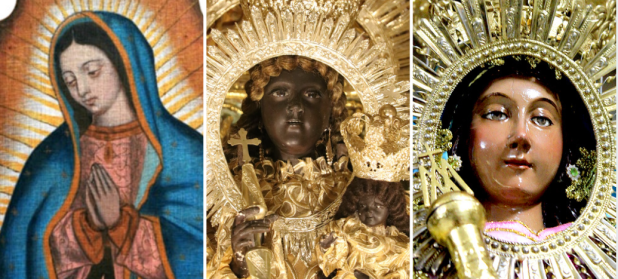
Whenever we would hear the name “Guadalupe”, we would immediately associate it to the famed Virgin of the Tilma of Mexico given with our rich historical link with the latter and maintained such relationship for centuries. Numerous churches, shrines, chapels, schools, establishments, and women were named after the Virgin of Guadalupe in her honor.
Interestingly, if we are going to look further on the devotion to Our Lady of Guadalupe, we would be surprised that apart from the famed Virgin of Mexico, there would be a different image of the Virgin of the same name – this time holding the Child Jesus and presented as a regal Queen Mother like its original counterpart in Extremadura, Spain.
Given these thoughts in mind, we are going to look deeper into how the name “Guadalupe” would be synonymous with two distinct and famous devotions of the Hispanic world and its devotions in the country as we celebrate the Feast of the Virgin of Guadalupe – the Celestial Patroness of the Philippine Islands.
The name “Guadalupe”
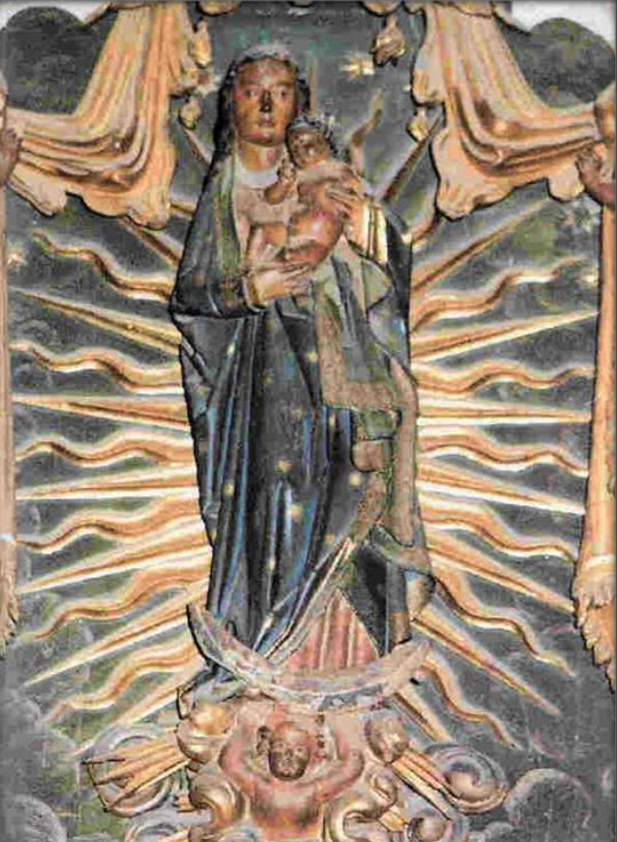
One might be mistaken that the name “Guadalupe” was Mexican and of Spanish origin. Interestingly, recent studies showed that the name “Guadalupe” was actually a Spanish version of the Arabic word “Wadi-al-lubben” meaning “the hidden river” or “the beautiful river”. We have to keep in mind that Spain was once conquered by the Arab-speaking Moors from Northern Africa and there were Spanish words that were later incorporated into the Spanish language. The term Wadi-Al-Lubben describes the place where the river actually narrows as it approaches the town of Guadalupe in Extremadura – hence the name of the location and was later used to the name the Virgin of Extremadura.
The name “Guadalupe” would later evolve when she made her appearance in 1531 at St. Juan Diego. A few days after the Miracle of the tilma happened, St. Juan Diego was accompanied by Spanish clergy, officers, and new converts to his home to check on his uncle Juan Bernardino. All of them were amazed when they saw Juan Bernardino was cured of his illness and he too was graced with an apparition of Our Lady. The Virgin revealed that she wished that the image will be known as “Santa Maria de Guadalupe”. The title Guadalupe that Juan Bernardino revealed might have been mistranslated by the Spaniards for it is believed that what the Virgin actually wished to be called in her Nahuatl (The language of the Aztecs) name as “Santa Maria de Tecoataxopeuh” (some scholars would say it was “Santa Maria de Coatlaxoepuh”) which means “The one who crushes the head of the Serpent”, a further Confirmation of her Immaculate Conception which at that time, was not yet declared a Dogma of Faith until December 8, 1854, with the bull “Ineffabilis Deus”.
We can see in the narrative of the devotion how the name became synonymous with the two great devotions of the Spanish realm and continues to flourish up to the present. It can be also seen as an act of providence that the two distinct devotions that share the same name would play important roles in the evangelization and history of the so-called Old and New World.
La Guadalupana of Extremadura, Spain
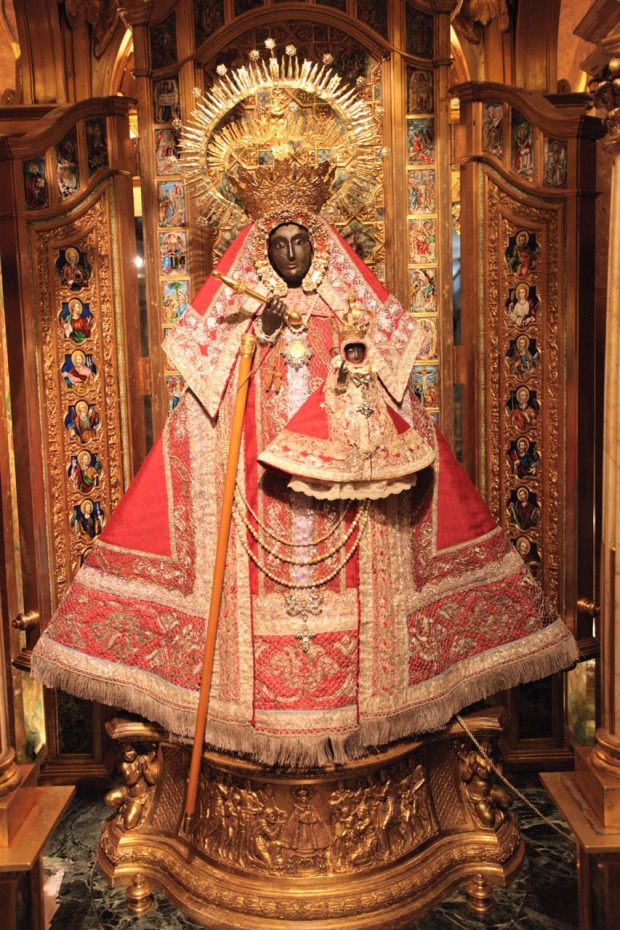
The devotion to Virgen de Guadalupe of Extremadura in Spain began sometime in 580 when it is said that Pope St. Gregory the Great gave the original statue (believed to be carved by St. Luke the Evangelist), to St. Leander of Seville, Bishop of Seville, Spain. The Virgin of Guadalupe of Extremadura gained much popularity yet the Virgin needed to be buried along with its church bell and important documents pertaining to the cultus to protect it from the Moorish invasion.
Centuries later, a cowherd was searching for his lost cow and followed it into the mountains until he found the cow lifeless. As he is about to butcher the cow, a voice came out of nowhere and beheld a beautiful lady. The Lady told him to dig nearby the cow’s resting place and he will her image and wished that a chapel will be built in her honor. After the vision disappeared, the cow came back to life and began to dig. As he was digging, he found the image of the Virgin of Guadalupe of Extremadura together with the bell it’s the documents that were buried for centuries.
Miracles soon took place in that spot where a chapel was built in honor of the Virgin. The place became a very important place in the Spanish kingdom from a pilgrimage made by the King of Spain in 1340 in thanksgiving on his crusade to expel the Moors from Spain and its role in the voyage to the New World where King Ferdinand and Queen Isabela made a pilgrimage to discern for this historic venture headed by Christopher Columbus which they later approved.
The Cultus of La Guadalupana de Extremadura in the Country
The devotion to the Virgin of Guadalupe of Extremadura was introduced in the country at the Augustinian Church of Nuestra Señora de Gracia in San Pedro de Macati (now the modern-day Makati City) and at the Parishes at Loboc and Sevilla, Bohol.
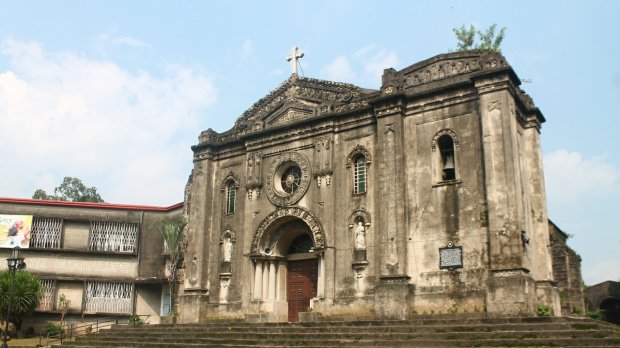
The Guadalupana de Extremadura devotion in Makati began when the Spanish population in the country clamored to have the Virgin under this particular sobriquet in 1604. The devotion to the Virgin of Extremadura grew and numerous miracles were attributed to her intercession. By 1632, the devotion had spread and devotees thronged into the Shrine to pay their respects to the Virgin. It became such a habitual courtesy that the authorities were forced to put up a landing dock at the foot of the hill by the river. A wooden house and stairs of stone of around one hundred steps were built in order to accommodate the pilgrims.
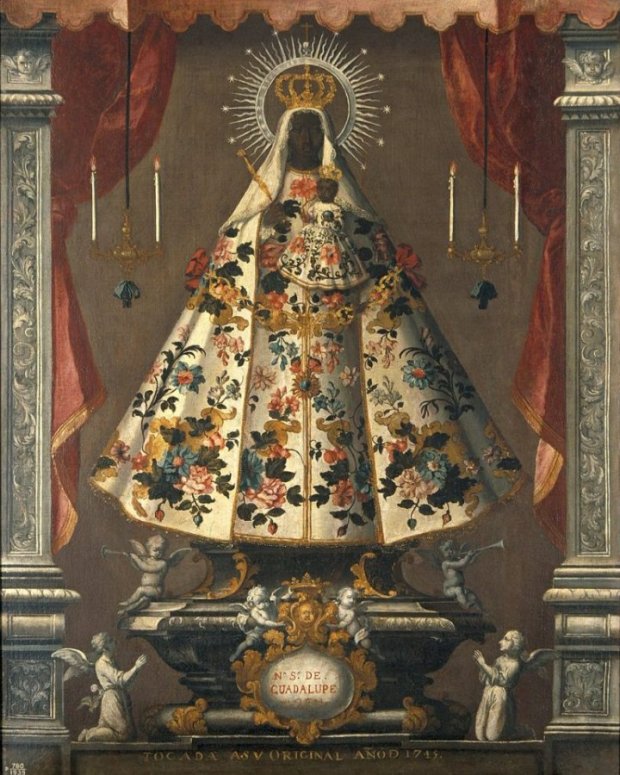
The 1754 eruption of Taal Volcano severely damaged Batangas province but spared the Guadalupe complex. In 1762, the occupying British soldiers converted it into their military headquarters. They desecrated the church, sacked the tombs, and divested images of their decorations and jewelry. The image of the Virgin of Guadalupe was spared due to the timely intervention of an Irish official who brought it to Pasig for safekeeping until 1764.
The 1880 earthquake caused considerable damage to the church. The masonry vault collapsed, which slackened the church buttresses and reduced the shrine in shambles. This earthquake also destroyed the original image of the Virgin of Guadalupe of Extremadura. A replica was made after six years by Melchor and Gaspar San Pedro to replace the original, and this image was venerated until 1899 when it was lost in the Philippine–American War, and the church was left in ruins for many years. When the Augustinian Friars returned in 1970, the ruined Church in Makati was reconstructed and rehabilitated, and rededicated to its original patroness – Nuestra Señora de Gracia.
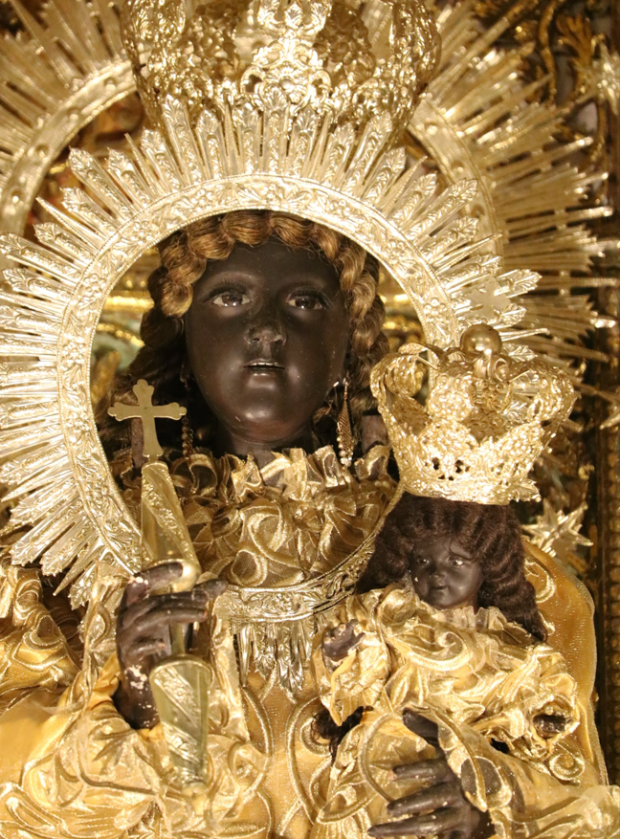
The Boholano devotion on the other hand began when a replica of the Virgin of Extremadura arrived in Loboc, Bohol in 1843. At that time, a cholera outbreak was plaguing the place that took the lives of many. The arrival of the image seemed to be providential that as soon as the image arrived, the cholera outbreak ceased. As of this writing, the image is currently enshrined in a provisional church since the original centuries-old church was one of the destroyed churches of the massive earthquake in 2013 until it was fully restored in 2021. On the 390th anniversary of the arrival of the image, the image received Episcopal Coronation on May 24, 2018 – the first Marian image in Bohol that received a formal ecclesiastical coronation rite. The Loboc Church was declared the Diocesan Shrine of Nuestra Señora de Guadalupe de Extremadura de Loboc and later granted the Spiritual Bond of Affinity with the Basilica of Sancta Maria Maggiore of Rome in 2021.
La Guadalupana of Mexico
A few centuries later, the Blessed Mother made her presence known and permanent in a newly discovered New World while Europe was losing many souls due to the Protestant Reformation.
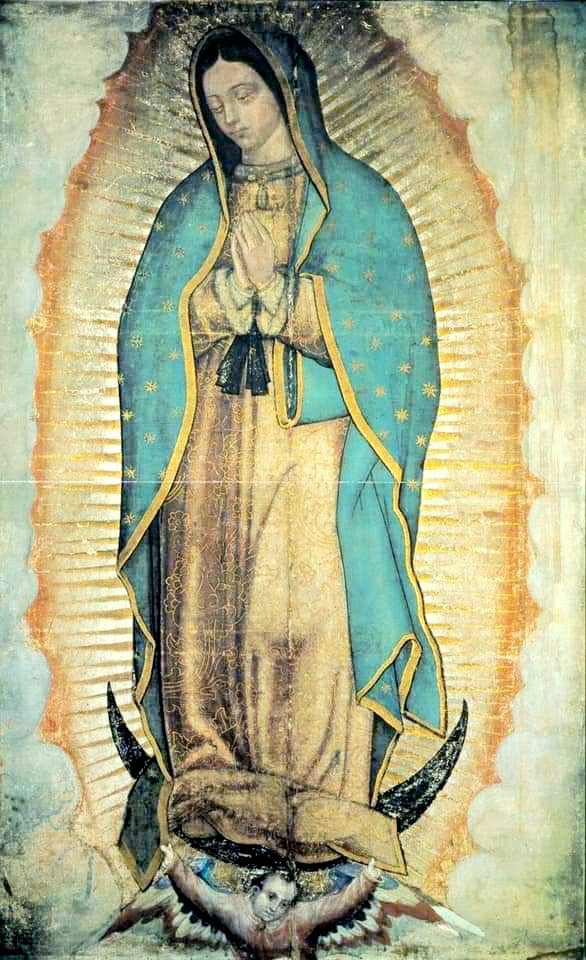
On the morning of December 9, 1531, the Virgin appeared to St. Juan Diego who was on his way to mass when he saw a maiden at the Hill of Tepeyac, in what would become the town of Guadalupe in the suburbs of Mexico City. Speaking to him in the Nahuatl language, the Virgin asked that a church be built in her honor. St. Juan Diego recounted the events to the Archbishop of Mexico City, Fray Juan de Zumarraga who instructed him to return to Tepeyac Hill and ask the “lady” for a miraculous sign to prove her identity. On December 12, 1531, the Virgin left her image permanently upon the tilma of St. Juan Diego. Her likeness was given as a sign to Bishop Zumarraga, who abided by her wishes and constructed a church on the site of the apparitions. That same tilma is an enduring and living miracle as new studies and discoveries about the famous tilma from its preservation, the colors, motifs, symbolism, and other obscure elements would continue to baffle scientists and strengthen the faith of her devotees.
Millions of natives were converted to Christianity during the period following her visit with numerous miracles attributed to her intercession and the devotion spread throughout the New World, in Europe, and in Asia in the coming centuries. One of the most notable of the miracles of the Virgin outside Mexico was during the Battle of Lepanto in 1571 which saved Christian Europe.
In 1555 In the Provincial Council, the second archbishop of Mexico, Alonso de Montúfar, formulated canons that indirectly approved the apparitions. A formal inquiry and investigation were conducted by the Church from February 18 to March 22, 1666, and again by Archbishop Lanziego y Eguilaz in 1723. In 1887, Pope Leo XIII granted the Pontifical Coronation of the image, which occurred on October 12, 1895. Pope Pius XII accorded her the title “Queen of Mexico and Empress of the Americas” in 1945, and “Patroness of the Americas” the following year.
The Devotion and Patronage in the country
The apparitions of Our Lady of Guadalupe in 1531 in Mexico made a huge impact in the New World because of the massive conversions in the Western Hemisphere at the time when the Protestant movement is rampant in Europe that resulting in the loss of souls to the true fold. With the Reconquista of the Philippines in 1565, the devotion to Our Lady of Guadalupe was also introduced in the country and its first shrine was established in Pagsanjan, Laguna in 1687 and it would later spread in other parts of the country, especially in Cebu, Makati City, Zambales and other parts of the country with Parishes, shrines, and chapels dedicated to her.
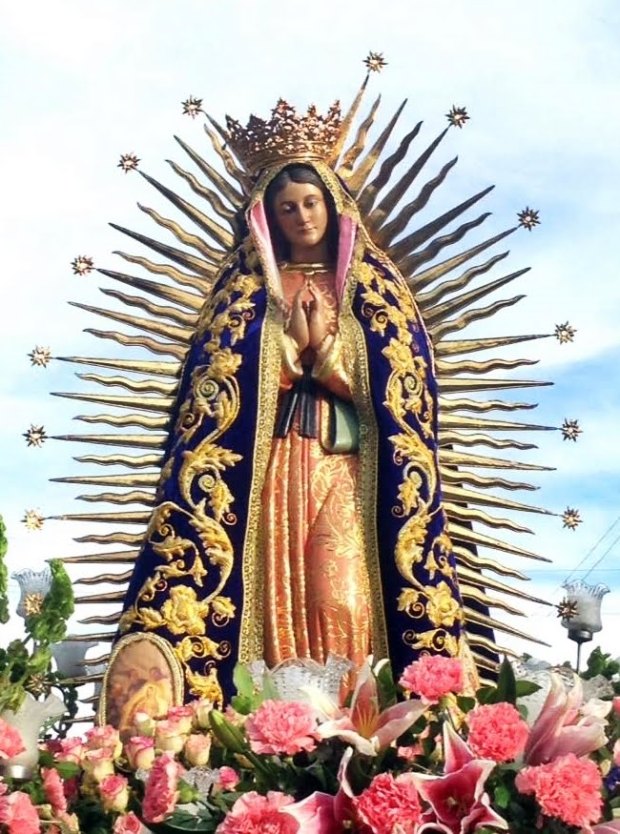
A Papal Bull was issued on July 16, 1935, by Pope Pius XI, issued a Papal Bull declaring the Virgin of Guadalupe of Mexico as the “The Celestial Patroness of the Philippine Islands” On November 13, 2001, the celebration of the Feast of Nuestra Señora de Guadalupe in the Philippines was declared an Obligatory Memorial.
The cult of the Virgin of Guadalupe in Pagsanjan, Laguna is the pioneer of the La Guadalupana Mexicana devotion in the country since 1687 by Franciscan missionary Fray Agustin de la Magdalena. The original image of the Virgin was donated by Father Agustin when the parish was first established and was installed at the main altar on December 12, 1688. Numerous miracles were attributed to her intercession, specifically, the protection of Pagsanjan from bandits, and an arch was built as a reminder of the miracle. Unfortunately, the original image was destroyed during the War, and two new images arrived in Pagsanjan as replacements, one is the altar image that was carved by Maximo Vicente and later in 1958, Mexican Catholics contributed a life-sized image of Our Lady of Guadalupe sculpted by Ramon Barretto of Toluca, Mexico. The Mexican image received Episcopal Coronation on December 12, 2012, along with the declaration of her parish as the Diocesan Shrine of Our Lady of Guadalupe.
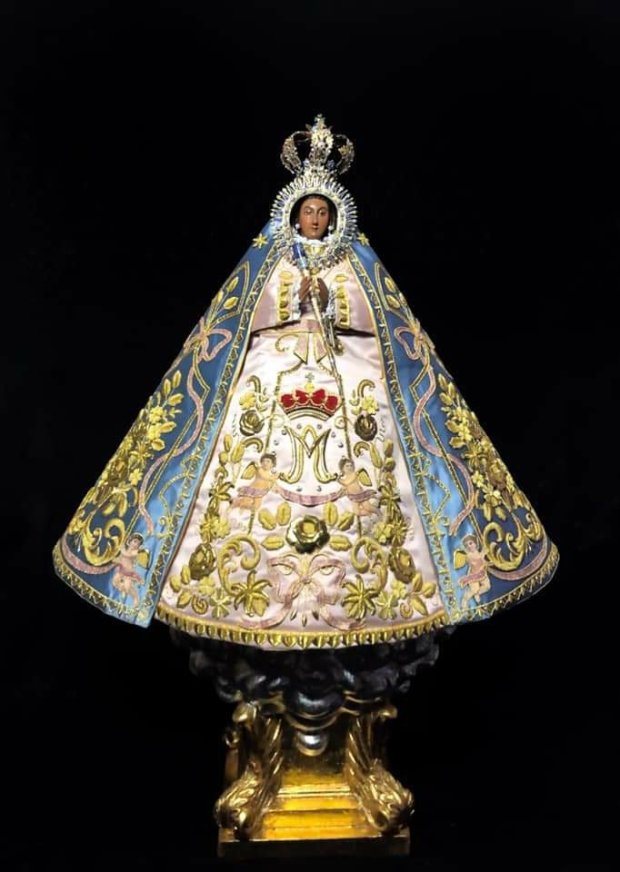
The Cebuano devotion to the Virgen of Guadalupe began when the image was found in 1880 by Ricardo Ramirez from a cave in Cebu and from it emanated a great light. Numerous miracles were attributed to Cebu’s Lady of Guadalupe over the centuries. One of the most notable miracles of the Virgin occurred in 1902 when a cholera epidemic took the lives of many Cebuanos they invoked the intercession of the Virgin of Guadalupe which she, in turn, did not turn a deaf ear and the epidemic stopped. A thanksgiving novena was held from July 8 – 16 that same year and the people celebrated July 16 as the second fiesta of the Virgin of Guadalupe of Cebu as an act of perpetual thanksgiving to her intercession to stop the epidemic. The Virgin was Pontifically Crowned on July 16, 2006, the 104th anniversary of the miracle, and was named the Patroness of Cebu in 2002.
From these recorded accounts of the cultus of the Mexican Virgin of Guadalupe, we see how the Virgin became the succor and protectress of these towns. As the modern age came, with numerous societal changes and reforms that took place, the patronage of the Virgin of Guadalupe would evolve. In 1955, the Minor Seminary of the Archdiocese of Manila was inaugurated and named after the Virgin of Guadalupe which would help in the formation of future priests in their lifelong mission to administer the faithful and bring the light of the Gospel.
As the threats of the culture of death begin to creep in in our society, she began to be invoked as the Pro-Life Patroness and the Protectress of the Unborn due to the fact that the image presents the Virgin as a Pregnant mother due to the placement of a belt on her waist which is Aztec culture, it denotes pregnancy. It is also interesting to note that there were also miracles that were associated with her saving children from abortion or safe delivery of mothers. In fact, on September 8, 2002, the Virgin of Guadalupe was named as Pro-life Patroness in response to the issues of human reproduction and mortality in the country in recent times.
A social dimension was added to the patronage of the Virgin, most notably in the devotion to the Virgin of Guadalupe in her National Shrine in Makati City where the plight of the marginalized and the protection of life is in focus.
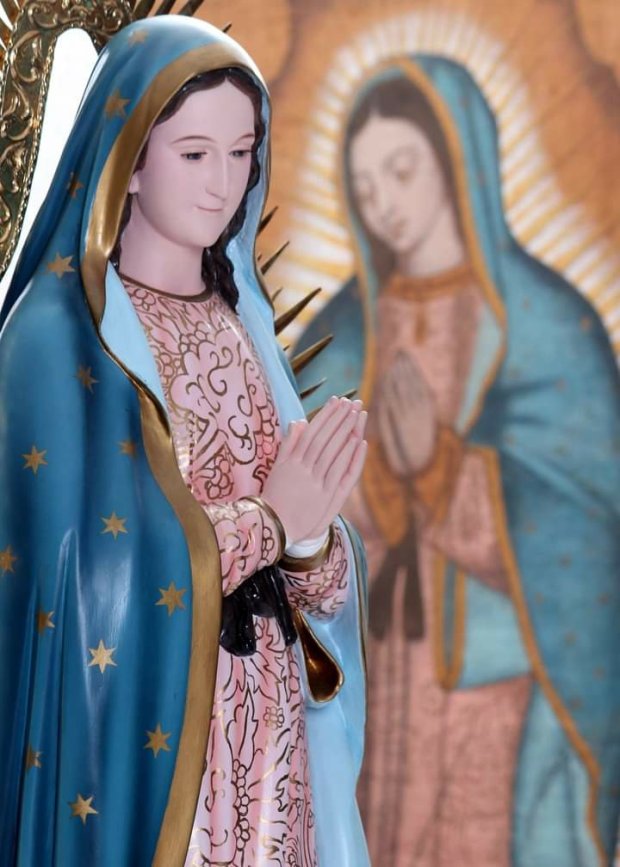
The devotion to the Virgin of Guadalupe of Mexico began when Archbishop Gabriel Reyes, DD, the first Filipino Archbishop of Manila, established the parish of Our Lady of Guadalupe in 1951. The parish became the solace of the people who cling to her protective mantle of protection from the culture of death that is plaguing our modern society. One of the most notable miracles of the Virgin of Guadalupe of Makati was during the SARS outbreak all over the world and in response, the late Archbishop Jaime Cardinal Sin, then the Archbishop of Manila at that time, requested that the Pilgrim tilma Image of Our Lady of Guadalupe be brought to his residence in Villa San Miguel to ask for the protection of the Philippines from the threat of SARS abated. The Virgin heeded the pleas of her children and things went back to normal for our country. On August 15, 2002, the Solemnity of the Assumption of the Blessed Virgin Mary, His Eminence, the late Archbishop Jaime Cardinal Sin elevated the Parish as the Archdiocesan Shrine of Our Lady of Guadalupe then as the National Shrine of Our Lady of Guadalupe on May 31, 2010.
As the digital and social media age came in, we would see an interesting development in the devotion to Our Lady of Guadalupe as the Patroness of the Youth of St. Rita Parish in the Province of Zambales.
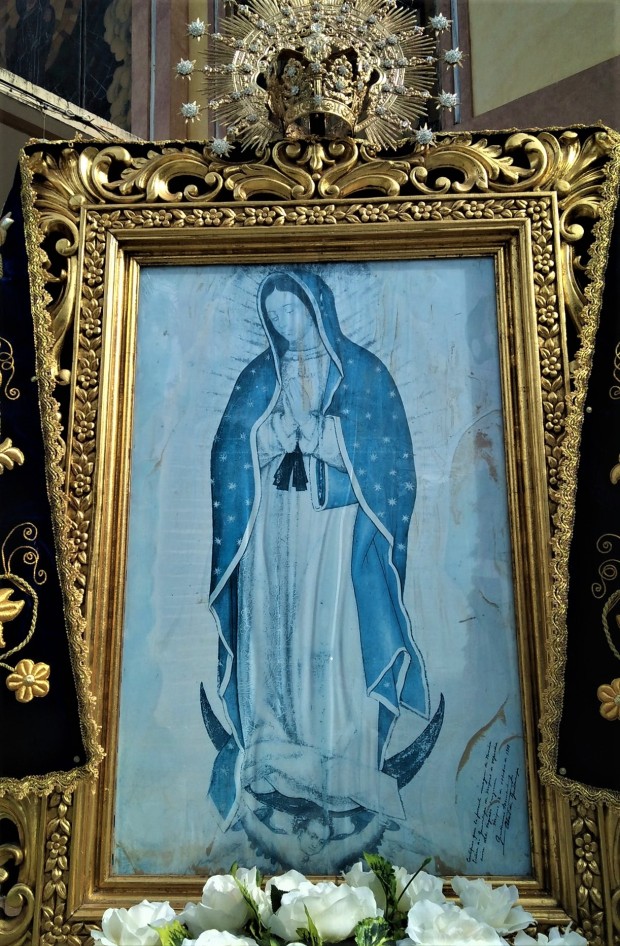
The devotion to the Virgin of Guadalupe in Santa Rita de Cascia Parish in Olongapo, Zambales when in 2005 when the youth leaders of the parish were introduced to the Virgin’s image and story by a nun during a retreat by narrating its history and distributed holy pictures and prayers to the Virgin. The parish youth leaders were moved by the account of the apparition that the devotion formally began with the celebration of the first Guadalupe fiesta that was held that same year with a print image of the Virgin enshrined at the parish as the focal point of the devotion. Numerous miracles were attributed to her intercession that the devotion grew over the years and the youth organization of the parish became the prime promoters of the devotion. On December 11, 2011, Bishop Florentino Lavarias, DD, then Bishop of Iba granted the Episcopal Coronation of the image of Our Lady of Guadalupe and was named as the Mother, Queen, and Patroness of Sta. Rita de Cascia Parish, Olongapo, Zambales.
The twinning of the Two Guadalupe Shrines

The union between the two Guadalupe Shrines in Spain and Mexico become stronger in recent years. On February 13, 2023, the Royal Monastery of Our Lady of Guadalupe in Caceres, Extremadura, Spain is now formally twinned with the National Basilica of Our Lady of Guadalupe in Mexico City, Mexico with a Holy Mass presided by Archbishop Francisco Cerro Chaves, Metropolitan Archbishop of Toledo, and Primate of Spain, formally making the twinning official with the signing of an agreement with the Primate of Mexico. Cardinal Carlos Aguiar Retes, Metropolitan Archbishop of Mexico City.
With this twinning of the two sanctuaries under the invocation of “Our Lady of Guadalupe” in Spain and Mexico, here are the commitments both sanctuaries must adhere to the following agreement:
- To celebrate solemnly in the Basilica of Tepeyac the Feast of the Virgin of Guadalupe of Extremadura in Spain every September 6, the designated feast of the Extremadura Shrine.
- To celebrate in the Basilica of Extremadura the Feast of the Virgin of Guadalupe of Mexico every December 12.
- To enthrone one or the other invocation in the homonymous sanctuaries, meaning the Mexican Basilica will enshrine a replica of the Virgin of the Extremadura Sanctuary while the Spanish sanctuary will enthrone a reproduction of the tilma of the Mexican Virgin.
- To pray in the Spanish Basilica of the Virgin of Guadalupe for the brotherly union with the Mexican people, and also in the Mexican Basilica for the Spanish people.
- To seek the dissemination of knowledge of both apparitions of the Blessed Mother, united under a common dedication, to strengthen the ties between the devout devotees of Our Lady of Guadalupe in Extremadura, Spain, and Mexico City, Mexico.
The Devotion at Present
After we have touched on the different facets of the devotion to the Virgins of Guadalupe of Extremadura and Mexico, we saw how the devotion gained much footing in our country – one with her constant protection to her realm while the other was the ever-evolving patronage needed of the time.
Her words to St. Juan Diego of Mexico “Am I not here, I, Your Mother?” is still as comforting and important as it is today, especially in our present time. Now we see, looking at it in the eyes of the faith, that in this surprisingly diverse devotion to the Virgin of Guadalupe, we realized how Our Lord cared so much for our souls that she gave His Immaculate mother as a channel and distributor of His graces that flow like a beautiful river that helped change the course of history and a remedied the needs and struggles of the time.
Our Lady of Guadalupe, Pray for us!
References:
Alvarez, Prieto, Fernando. La Virgen del Tepeyac: historia, leyendas y tradiciones referentes a la maravillossa aparicion de la Virgen de Nuestra Senora de Guadalupe de Mexico. Barcelona: Mexico: J.F. Parres, 1883.
Aviado, Lutgarda, Madonnas of the Philippines, Manlapaz Press, Quezon City, 1972.
Bagui, Marjun, “Our Lady of Guadalupe de Cebu: A Homage”, Retrieved from https://www.philstar.com/cebu-news/2009/12/10/530799/our-lady-guadalupe-de-cebu-homage#GZiq2fB3pWEp1c1W.99on December 5, 2021.
Barcelona, Mary Anne, Ynang Maria: a celebration of the Blessed Virgin Mary in the Philippines. Ed. Consuelo B. Estampa, P.D. Pasig City, Anvil Publishing Inc., 2004.
“Bohol’s Feast of Our Lady of Guadalupe”, Retrieved from http://www.bohol-philippines.com/the-feast-of-our-lady-of-guadalupe.html on May 12, 2018.
“Decree of Episcopal Coronation of Nuestra Senora de Guadalupe de Extremadura de Loboc”, Diocese of Tagbilaran, Bohol, 2018.
Dorcy, Sis. Mary Jean, OP “Shrines of Our Lady”, Sheen and Ward, New York, USA, 1956.
Esparza, Daniel, “Is Guadalupe a “Mexican” name?”, Retrieved from https://aleteia.org/2017/06/29/is-guadalupe-a-mexican-name/ on December 11, 2021.
Galende, Pedro G., Angels in Stone: Augustinian Churches in the Philippines, San Agustin Museum, Manila, 1996.
“Holy Mary of Guadalupe: Patroness of the Philippine Islands as Declared by Pope Pius XI on 16 July 1935”, Retrieved from https://monkshobbit.wordpress.com/2009/02/16/holy-mary-of-guadalupe-patroness-of-the-philippine-islands-as-declared-by-pope-pius-xi-on-16-july-1935/ on December 11, 2017.
Jose, Salvador R., Novena in Honor of Our Lady of Guadalupe, Pro-Life Patroness especially of the Unborn, Sick, Aging, Disabled and others, Paulines Publishing House, Makati City, 2011.
Mary, Francis. A Handbook on Guadalupe, Ignatius Press, 1997.
Sanchez, Francisco, La Virgen Maria Venerada en sus Imagenes Filipinas, Manila: Imp. De Santos y Bernal, 1904.
Interviews:
Buñag, Ronald – National Shrine of Our Lady of Guadalupe, Guadalupe Nuevo, Makati City
Mendez,Ellis Manuel – Archdiocesan Shrine of Our Lady of Guadalupe de Cebu and Diocesan Shrine of Our Lady of Lourdes, Punta Princesa Cebu
Photos:
Ricaplaza, Nikko Marc Abadiano of Vestuario Sagrado
Malabanan, James Benedict
Naval, Wilfred Jason of My Religious Journey
National Shrine and Parish of Our Lady of Gudalupe, Makati City.
St. Peter Parish – Diocesan Shrine of Our Lady of Guadalupe de Extremadura, Bohol
St. Rita of Cascia Parish, Olongapo, ZambalesMalabanan, James Benedict
Naval, Wilfred Jason of My Religious Journey
St. Peter Parish – Diocesan Shrine of Our Lady of Guadalupe de Extremadura, Bohol
St. Rita of Cascia Parish, Olongapo, Zambales
+AMDG+ +AMPSPC+
